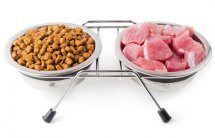raw pet food

“For most animals, it’s more beneficial than processed foods, ” says Doug Knueven, DVM, of the Beaver Animal Clinic in Beaver, Pa.
Knueven specializes in holistic medicine and also consults for Nature’s Variety, a Lincoln, Neb.-based manufacturer of frozen raw food diets as well as cooked dry and canned foods.
Barbara Benjamin-Creel of Marietta started giving raw food to her three dogs after Scooter, a German Shepherd, was diagnosed with cancer. The diet change came too late to help Scooter, she says, but the other dogs are thriving after two years on raw dog food. The 11-year-old dogs seem more energetic, and one with chronic digestive problems tolerates the raw diet better.
“The change in the coat was pretty immediate, ” Benjamin-Creel says. “Also, their breath was much better.”
Benjamin-Creel makes the food herself, giving yogurt in the morning and raw ground pork, turkey, or beef mixed with some rice in the evening. To cut costs, she stocks up on ground meat when it’s on sale. “It’s not cheap, ” she says, “but I think we’ve avoided a lot of old-age issues.”
The cost of a raw dog food diet varies with the ingredients used and how it is prepared. For a 30-pound dog, a one-day supply of one variety of a frozen, commercially available raw chicken diet costs about $2.50; others may range up to $5 a day. A super-premium, commercial dry dog food costs about $1.
Raw Dog Food Diet: What the research shows
Lisa M. Freeman, DVM, PhD, headed an evaluation of raw dog food diets published in the Journal of the American Veterinary Association in 2001. She cautions pet owners against them, saying that many dog owners are choosing raw diets based on online myths and scare tactics about commercial pet food.
For pet owners who want to avoid commercial food, Freeman advises a cooked homemade diet designed by a nutritionist certified by the American College of Veterinary Nutrition.
Freeman, a nutrition professor at the Cummings School of Veterinary Medicine at Tufts University, says that many of the benefits attributed to a raw food diet for dogs, such as a shinier coat, instead are the result of the high fat composition of the typical raw diet. High-fat commercial foods that would produce the same effect are available, she notes, without the risk of an unbalanced diet. Supplements can also be used as an alternative to increasing fat in the diet.
Continued
The evaluation looked at five raw diets, three homemade and two commercially available. All had nutritional deficiencies or excesses that could cause serious health problems when given long term, according to the report.
Joseph Wakshlag, DVM, PhD, has seen those problems appear in some dogs as poor coats, bad skin, or weak bones. Too little fat means a bad coat; but too much fat and not enough protein can cause mild anemia, says Wakshlag, an assistant professor of clinical nutrition at Cornell University College of Veterinary Medicine.
Wakshlag - who accepts some research funding from Nestle Purina PetCare - says homemade raw diets also may lack enough calcium and phosphorous, causing bone fractures and dental problems. Depending on the quality of the diet, the calcium or phosphorus may also be difficult to properly digest, even if present in adequate amounts.
Studies of raw pet food also have shown bacterial contamination. The FDA issued suggestions in 2004 for manufacturing raw pet food more safely, citing concern about the possibility of health risks to owners from handling the meat. A 2006 study of 20 commercially available raw meat diets found that 7.1% contained a type of salmonella. E. coli bacteria was found in 59.6% of raw meat diets. These bacteria can also be shed in the feces, leading to a potential source of human exposure and infection.
The study also sampled four canned and dry dog foods. It found E. coli in all of the commercially processed, cooked foods during one of the four sampling periods, and in one brand of dry food during another sampling period.
Raw Dog Food Diet: Concerns Overblown?
Supporters of raw dog food diets are quick to point out that commercially processed pet foods can contain harmful bacteria, as can raw meat offered for human consumption.
“The whole concern about bad bacteria is overblown, ” Knueven says. “When people are feeding a raw diet they know it’s not sterile, and they’re more careful about washing their hands. Feeding a raw meat diet is no different than cooking chicken for the family ... you have to clean up the counter and your knife.”
The FDA guidance document also suggested that manufacturers address typical nutrition problems in a raw-meat diet, including making sure it contained enough calcium and phosphorous, important for bone health. Raw-meat diets high in liver also may supply too much vitamin A, which can lead to vitamin A toxicity if fed for an extended period.
Even veterinarians like Knueven who support raw dog food diets say that they’re not appropriate for all dogs. Because the diets are typically high in protein, they aren’t appropriate for dogs with late-stage kidney or severe liver failure.
He recommends that dogs with pancreatitis or other digestive issues start with a cooked, homemade diet and clear up problems before switching to raw. Dogs with cancer, on chemotherapy, or dogs with other immunosuppressive diseases also should not eat raw food. And puppies aren’t good candidates, either.
“The only place I’ve seen a problem with this diet is puppies, ” Knueven says. “If you don’t get the calcium and phosphorous ratio right, you can have bone deformities and growth issues.”
Related posts:










